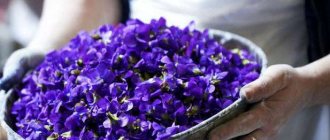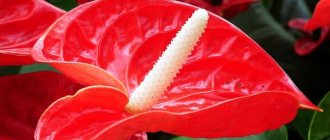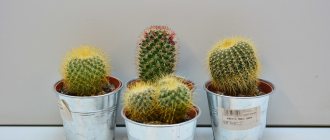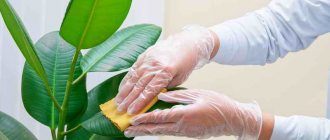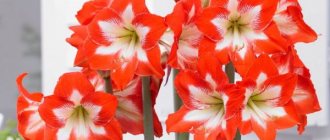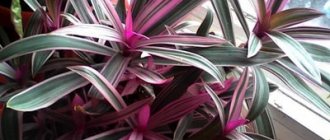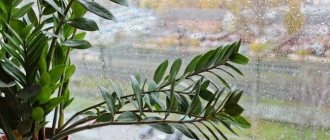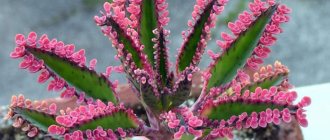Growing Kalanchoe at home. Signs and recommendations of Feng Shui.
Plants play different roles in human life. They are medicine, weeds, and pets. Among the latter, Kalanchoe occupies a worthy place among housewives.
It grows and produces long-lasting blooms in response to reasonable care and attention. Although it is recognized as an unpretentious plant in terms of watering, fertilizing and replanting.
Is this really so? Let’s continue to look into the article.
What is Kalanchoe blooming, what it looks like, how it blooms: description
flowering Kalanchoe in pots
Kalanchoe in our latitudes are hybrids of plants from Madagascar. It belongs to the succulent family Crassulaceae. In total, more than 200 of its species are known.
Flowering Kalanchoe has gained maximum distribution and popularity in varieties such as:
- Blossfeld
- pinnate
- Daigremont
- single-flowered
External parameters of the plant:
- low up to 30 cm
- the leaves are large, fleshy, elastic, oval in shape with a serrated edge
- flowers are small, connected in inflorescences
- flower shape - tube with 4 petals
- during the flowering period, cover the surface of the plant with a dense carpet
- range - from white to rich red
Healing properties
The healing properties of Kalanchoe have been famous since ancient times. The indigenous aborigines of those regions used it as a bactericidal, anti-inflammatory, and hemostatic substance. Mostly juice was used, but they could also use dried leaves.
After Kalanchoe was exported to European countries, local residents grew it as an ornamental plant for beauty. It was only in the second half of the twentieth century that the composition and pharmacological properties began to be studied.
It turned out that the drink from this plant contains:
- malic, citric and oxalic acid;
- micro- and macroelements: magnesium, calcium, iron, copper, manganese;
- hydrochloric acid (more than 30%);
- polysaccharides (up to 40%);
- small amount of tannins
- flavonoids;
- vitamins C and P.
The combination of these substances provides medicinal varieties with such healing properties as:
- antiseptic, suppressing pathogenic microflora;
- hemostatic;
- regenerating;
- immunostimulating;
- removal of toxins.
Due to such a rich composition, Kalanchoe has found use in folk and traditional medicine. Medicinal products are produced from its juice. For example, in the instructions for one of these medicines, the indications for use include: stomach ulcers, non-healing wounds, minor burns, bedsores. Treatment for cracked nipples is indicated for nursing mothers. Juice can cure some dental diseases, for example: gum disease, periodontitis and others.
https://youtu.be/oFHXNWYoe-I
Kalanchoe - can you keep it at home: the meaning of the flower, signs and superstitions
A blooming Kalanchoe in an eco-bag is an excellent gift for all occasions.
Kalanchoe has medicinal qualities and is beneficial for humans. Therefore, be sure to get yourself this plant. It is quite patient and accepts minimal self-care with gratitude.
As for signs, they all have a positive meaning. Kalanchoe is not a magnet for dark forces, outbreaks of quarrels and abuse, diseases and troubles.
Vice versa:
- Kalanchoe absorbs heavy energy accumulated at the end of your working day
- cleanses the aura of the house, removes negativity from space
- promotes harmonization of family relationships
- encourages changing negative thoughts to positive ones
- brings the family together for pleasant conversations
- if your Kalanchoe blooms, it means that harmony, peace and harmony reign in the house
However, think about it if:
- your green pet suddenly began to fade and died, which means he took upon himself an external dark attack aimed at destroying the harmony of your family,
- it has been living with you for many years and does not bloom, which means there is a lack of sincerity, depth of relationships, and harmony in your family.
How to water Kalanchoe in winter and summer at home?
watering can with water near pots with Kalanchoe
Since Kalanchoe is not a picky plant, caring for it is not difficult.
On the other hand, like any other green resident of your home, it is sensitive to excess moisture, cold, and a complete lack of sunlight.
In summer, water Kalanchoe sparingly once a week.
- Choose water that has stood indoors for a day.
- Avoid pouring cold tap water under the roots of the Kalanchoe plant.
- Leave the plant stem without drops of moisture so that it does not provoke disease.
- Soak the soil with moisture so that water does not remain on the surface or in the base of the pot. In the second case, pour it out immediately.
- Remember that Kalanchoe comes from the tropics, so it tolerates a short period of drought more easily than an excessive amount of water in the soil. After all, it tends to accumulate moisture in its leaves and stems, which it uses during dry periods.
In winter, reduce the frequency of watering to once every 1.5-2 weeks.
- Gently lift the leaves before watering. Avoid accumulating water on them to avoid starting the processes of rotting and disease.
- Reduce the amount of water for one watering by half. It is better to wait until the soil in the Kalanchoe pot is completely dry and then water it, rather than adding liquid to wet soil. This way you will reduce the likelihood of the plant freezing and stress from the watering procedure.
- The water temperature should not be lower than room temperature in which the Kalanchoe lives.
The general principle for watering at any time of the year is good impregnation of the earthen clod, but without flooding.
Reviews from real people
What do people who grew it and used it for medicinal purposes say about Kalanchoe?
Feedback on the forum
Feedback on the forum
Feedback on the forum
Feedback on the forum
There are a lot of reviews and mostly they are all positive.
How to replant a flowering Kalanchoe?
young Kalanchoe seedlings in pots after transplanting
Consider a number of parameters before transplanting:
- choose the diameter of the new pot a couple of centimeters larger than the previous one
- plan the procedure for the end of March - mid-April and repeat every year
- maintain soil composition to speed up plant adaptation
Procedure:
- fill the new pot with drainage and soil 50%
- Carefully remove the Kalanchoe from the old pot. Leave its roots with a lump of earth
- install in a new flowerpot and add soil
- lightly tamp the soil around the stem
- Water the plant in a new pot moderately
- feed it for a week until it fully adapts
What kind of soil is needed for Kalanchoe?
a mixture of soil in the hands of a girl before pouring into pots for replanting Kalanchoe.
The ideal composition of soil for replanting and growing Kalanchoe at home is a combination of elements from equal whole and half parts. Namely:
- leaf humus, turf soil and coarse sand, taken in equal whole shares
- charcoal and brick chips - in halves
Use bone meal as fertilizer. 1 g per 1 liter of soil mixture is sufficient.
- Observe the acidity level of the soil for Kalanchoe. The first can vary within 5.0-6.5 pH.
- You can either buy a ready-made mixture in specialized stores, or prepare it yourself. In the second case, additional sterilization is needed.
Application in cosmetology
Homemade cosmetics from Kalanchoe are very effective and quite popular. Women have learned to use its beneficial properties to be beautiful, for which they prepare masks or lotions. It should be remembered: if the cosmetic product causes irritation or any other negative reaction occurs, the procedures must be stopped.
For beautiful facial skin
Kalanchoe can normalize the skin, cleanse pores, remove excess fat, get rid of rashes, and lighten age spots.
To cleanse the skin and acquire a beautiful color, you need to remove the skin from the leaf and wipe your face with the pulp. Then lightly slap the skin and wait until the healing composition is absorbed. Without washing your face, immediately apply moisturizer to your face.
If you need to dry out overly oily skin a little, add linden, chamomile and mint leaves to a small amount of boiling water and drain the water after half an hour. Mix Kalanchoe juice with steamed herbs and apply to facial skin for 20–25 minutes.
Lotion for youthful skin
This product can be used not only on oily but also on dry skin. Mix a tablespoon of juice and half a glass of boiled water with a teaspoon of honey. You can use this product after washing your face in the evening as a skin care product.
For beautiful hair
Useful products based on Kalanchoe - masks and decoctions - make hair stronger, thicker and softer, and give it a beautiful shine.
For the mask, you need to mix a teaspoon of Kalanchoe, garlic and birch juices, as well as honey. Add egg yolk, stir. Apply to hair, distribute the mask over its entire length, wrap cling film around your head and place a large towel on top of it. After 2 hours, wash off the mask with shampoo.
For hands and nails
Kalanchoe does an excellent job of softening hands. In addition, thanks to the antiseptic properties, its juice treats nail fungus, as a result, both the nail plate and the cuticle quickly return to a normal, healthy state.
You can mix a drop or two of Kalanchoe juice with your regular hand cream, which is used daily. It is better to lubricate your hands before going to bed, and then put on special cotton gloves.
To get rid of fungus, wrap each nail with gauze soaked in juice. Then put on cotton gloves. Repeat the procedure every day, or at least every other day, until the fungus disappears.
How does flowering Kalanchoe reproduce?
healthy Kalanchoe seedlings on a plate before planting.
Flowering Kalanchoe can reproduce in 2 ways:
- vegetative, that is, cuttings, leaves
- seeds
In the first case, choose:
- healthy material,
- warm season, when the duration of the daylight hours is at least 12 hours and the temperature does not drop below +24℃,
- a well-lit place, but without direct sunlight.
In the second:
- different soil composition. It should be made of peat and sand, taken in equal parts,
- regularly ventilated room with a temperature not lower than +18℃,
- insulating the pot with cellophane until the seeds germinate. This usually occurs 7-10 days after sowing.
Reproduction
The most convenient way to obtain new individuals is by cuttings. It is allowed to cut stems and leaves into cuttings.
Stems
After cutting the cutting with a sharp, disinfected knife, dry it, leaving it for 5-6 hours. After this, you can install it in damp sand or use a container of water for rooting.
Sand is preferable because the root formation process will go much faster, and after 6-7 months the sprout will bloom.
Leaves
The rooting process by this method is no different from the method described above. Only when propagated by leaves, you will have to wait a little longer for flowering - at least a year.
How to prune Kalanchoe after flowering?
trimmed peduncle of Kalanchoe after all the flowers have withered
- Make sure all flowers are wilted.
- Using garden shears, remove the peduncle as far down to the roots as possible. Then no fungi and mold are afraid of him.
- And also cut off the outer 2 leaves on each branch of the plant. In this way you will stimulate the growth of Kalanchoe with a regular oval shape.
Kalanchoe should be pruned not only after flowering, but after purchase and for preventive purposes.
Trimming
Kalanchoe is a growing plant that requires rejuvenation. Pruning is required after flowering and to create a lush bush.
How to prune Kalanchoe to have a beautiful bush? There are several ways to trim:
- If the plant is mature and has stretched upward, cut the cuttings generously. They are laid aside for reproduction, and new branches await at the site of the cuttings. Cuttings can be replanted on an adult plant and the bush will become more luxuriant.
- The lower side leaves of a young plant are cut off. Thus, side shoots grow at the cut site and the bush becomes rounded.
- After flowering, be sure to cut off the flower stalks and put the plant to rest.
Pruning is necessary for lush flowering of Kalanchoe. The more the bush is pruned, the more branches will appear at the cut site, and each branch, in turn, produces flower stalks.
Pruning must be done in the spring season.
Why do Kalanchoe leaves turn yellow, curl, dry out and fall off?
Kalanchoe leaf tips dry out.
There are several reasons for this phenomenon, depending on the nature and location of the affected leaves.
- If these are only the top ones, then the plant does not have enough sun light.
- If only the lower ones - you allowed the soil to dry out and have not watered the Kalanchoe for a long time. And also, perhaps, there is a too hot battery under his pot. Therefore, change its place to a cooler one.
A few more reasons:
- tightness of the pot,
- the plant is aging, which means it’s time to pinch off its healthy shoots/leaves and take rejuvenation measures,
- infestation with aphids, if a similar situation occurs in the summer, and the plant itself lives on the balcony or in your garden.
Diseases
If improperly or improperly cared for, the succulent may become sick. A common disease is powdery mildew on Kalanchoe. It appears because the plant is kept in an extremely warm place, or suffers from excessive watering.
Why do Kalanchoe leaves turn yellow and dry?
Yellowness and drying of the leaf blades may indicate that the flower lacks moisture or is experiencing discomfort in a hot place, perhaps next to a radiator or heater. To fix the problem, you need to place the pot with the succulent in a cooler place and try spraying it with water.
Why does Kalanchoe shed its leaves?
Falling leaves may indicate that the plant is cold. If the room is warm enough, it means the succulent is withering, experiencing a lack of nutrients and needs urgent feeding.
Why do Kalanchoe leaves curl?
This can happen if the plant is exposed to temperature changes. In winter, cold air comes from the windows, and warm air from the radiator. Also, excess nitrogen in the soil will provoke this behavior. Insufficient humidity in the room and the presence of insect pests can cause leaf curling.
Kalanchoe does not bloom and stretches upward: what to do?
Kalanchoe stretched up and without flowers
First, determine the possible cause. It's either:
- lack of sunlight, which the plant reaches for
- daylight hours are too long, 12 hours or more
There are also 2 ways out of this situation:
- move the pot of Kalanchoe to the windowsill without any neighbors other than succulents,
- monitor the length of the day for the plant, cover it with opaque polyethylene in the evening until the morning.
Kalanchoe begins to form flower stalks when:
- he has enough strength, that is, watering and fertilizing are normal
- he sees sunlight for no more than 10 hours at a time
Pests
The most common pests that can attack succulents are aphids, mealybugs and spider mites. You can determine that a flower is affected by spider mites by a whitish coating similar to a cobweb. Mealybugs can also attack the flower. The flower will develop a white coating on the leaves. With this disease, Kalanchoe leaves curl and fall off. To combat parasites, you need to force them to leave the shelter; for this it is recommended to use a soap solution or resort to insecticides.
Where should a Kalanchoe flower be placed according to Feng Shui?
flowering Kalanchoes are located on the southern part of the house, therefore they bloom profusely.
According to Feng Shui, the best locations for Kalanchoes are:
- window sills on the south side of the house,
- the extreme left corner of the home - to attract abundance and wealth to the owners,
- left corner from the computer monitor for those who work in the dark. The plant absorbs fatigue and replenishes the worker's strength.
So, we have looked at the main stages of caring for a flowering Kalanchoe, the reasons for its drying out and pulling up. We learned about the benefits and favorable signs of having a plant in the house.
Get yourself a Kalanchoe if you haven’t already, and test the power of its healing effects in practice.
Kinds
The Kalanchoe plant, the varieties of which are quite numerous, can be selected according to your preferences. Among the most common ones cultivated in homes are the following.
Pinnate
It got its name because of the appearance of the leaves. The plant is quite large; with proper care, it can reach one and a half meters in height with age. The stem has a dense structure with a cavity inside and with age becomes covered with a rough crust at the base. This species is considered more in demand as a medicinal one.
Degremona
This plant is rightfully called “viviparous”, because “baby” shoots are formed along the contour of the leaf plate on the succulent. It is enough to move them to the surface of the soil to grow a new flower.
The stem is straight, the leaves are shaped like triangles. Degremona blooms in the form of pink or red buds.
Blossfeld
Unlike Blossfeld's previous brothers, Kalanchoe terry has more compact dimensions and does not exceed 50 centimeters in height (in adulthood). The flower acquired this property during the selection process in order to breed the most unpretentious specimens for home conditions.
The most popular succulent is characterized by the shape of a shrub with compacted leaves, to which inflorescences are attached in the form of branched stems. The color palette is quite wide - the buds can be colored from bright red to light green.
This is interesting: Blossfeld can easily be confused with another type of succulent, which is its direct “descendant”. Kalanchoe "Rosalina" (lat. Rosalina) has a similar bush shape, but the flowers differ in their double petals. The plant blooms mainly in white, yellow or orange.
